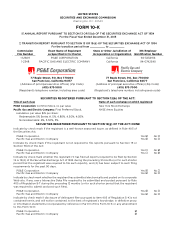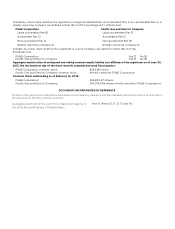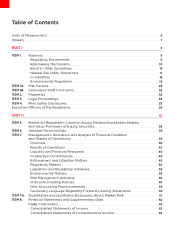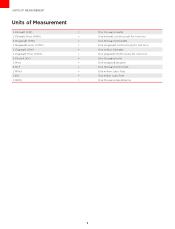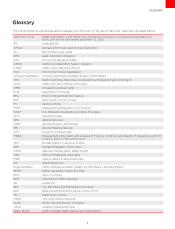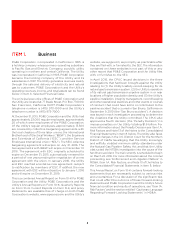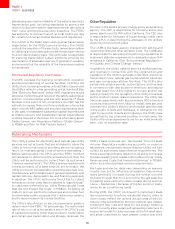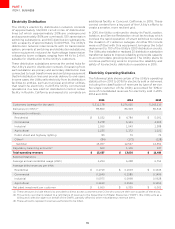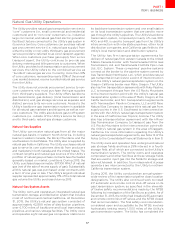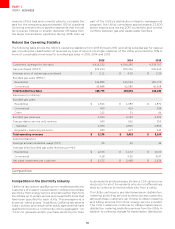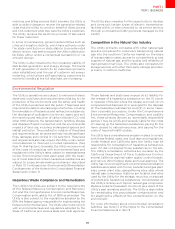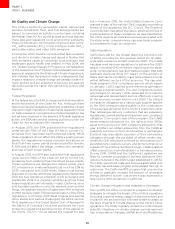PG&E 2015 Annual Report Download - page 18
Download and view the complete annual report
Please find page 18 of the 2015 PG&E annual report below. You can navigate through the pages in the report by either clicking on the pages listed below, or by using the keyword search tool below to find specific information within the annual report.
10
PART I
ITEM1.BUSINESS
standards governing the reliability of the nation’s electricity
transmission grid, including standards to protect the
nation’s bulk power system against potential disruptions
from cyber and physical security breaches. The FERC
has authority to impose fines of up to $1 million per day
for violation of certain federal statutes and regulations.
The CAISO is the FERC-approved regional transmission
organization for the Utility’s service territory. The CAISO
controls the operation of the electricity transmission system
in California and provides open access transmission service
on a non-discriminatory basis. The CAISO also is responsible
for planning transmission system additions, ensuring the
maintenance of adequate reserves of generation capacity,
and ensuring that the reliability of the transmission system
is maintained.
The Nuclear Regulatory Commission
The NRC oversees the licensing, construction, operation
and decommissioning of nuclear facilities, including the
Utility’s two nuclear generating units at Diablo Canyon and
the Utility’s retired nuclear generating unit at Humboldt Bay.
(See “Electricity Resources” below.) NRC regulations require
extensive monitoring and review of the safety, radiological,
seismic, environmental, and security aspects of these
facilities. In the event of non-compliance, the NRC has the
authority to impose fines or to force a shutdown of a nuclear
plant, or both. NRC safety and security requirements have,
in the past, necessitated substantial capital expenditures
at Diablo Canyon, and substantial capital expenditures
could be required in the future. For more information about
Diablo Canyon, see “Regulatory Matters – Diablo Canyon”
in MD&A and Item 1.A Risk Factors below.)
Other Regulation
The CEC is the state’s primary energy policy and planning
agency. The CEC is responsible for licensing all thermal
power plants over 50 MW within California. The CEC also
is responsible for forecasts of future energy needs used
by the CPUC in determining the adequacy of the utilities’
electricity procurement plans.
The CARB is the state agency charged with setting and
monitoring GHG and other emission limits. The CARB also
is responsible for adopting and enforcing regulations to
implement state law requirements to gradually reduce GHG
emissions in California. (See “Environmental Regulation—
Air Quality and Climate Change” below.)
In addition, the Utility obtains permits, authorizations,
and licenses in connection with the construction and
operation of the Utility’s generation facilities, electricity
transmission lines, natural gas transportation pipelines,
and gas compressor station facilities. The Utility also
periodically obtains permits, authorizations, and licenses
in connection with distribution of electricity and natural
gas that grant the Utility rights to occupy and/or use
public property for the operation of the Utility’s business
and to conduct certain related operations. The Utility has
franchise agreements with approximately 300 cities and
counties that permit the Utility to install, operate, and
maintain the Utility’s electric and natural gas facilities
in the public streets and highways. In exchange for the
right to use public streets and highways, the Utility pays
annual fees to the cities and counties. In most cases, the
Utility’s franchise agreements are for an indeterminate
term, with no expiration date.
Ratemaking Mechanisms
The Utility’s rates for electricity and natural gas utility
services are set at levels that are intended to allow the
Utility to recover its costs of providing service including a
return on invested capital (“cost-of-service ratemaking”).
Before setting rates, the CPUC and the FERC conduct
proceedings to determine the annual amount that the
Utility will be authorized to collect from its customers
(“revenue requirements”). The Utility’s revenue requirements
consist primarily of a base amount set to enable the
Utility to recover its reasonable operating expenses (e.g.,
maintenance, administration and general expenses) and
capital costs (e.g., depreciation, tax, and financing expenses).
In addition, the CPUC authorizes the Utility to collect
revenues to recover costs that it is allowed to “pass-through”
to customers (referred to as “Utility Revenues and Costs
that did not Impact Earnings” in MD&A), including its
costs to procure electricity, natural gas and nuclear fuel,
to administer public purpose and customer programs,
and to decommission its nuclear facilities.
The Utility’s rate of return on electric transmission assets is
determined in the FERC TO proceedings. The authorized
rate of return on all other assets is set in the CPUC’s cost
of capital proceeding. Other than its electric transmission
and certain gas transmission and storage revenues, the
Utility’s base revenues are “decoupled” from its sales
volume. Regulatory balancing accounts, or revenue
adjustment mechanisms, ensure that the Utility will fully
collect its authorized base revenue requirements. The
Utility’s earnings primarily depend on its ability to manage
its base operating and capital costs (referred to as “Utility
Revenues and Costs that Impacted Earnings” in MD&A)
within its authorized base revenue requirements.
Both gas and electric rates vary depending on seasons
mostly due to the influence of weather. Gas service
rates generally increase during the winter months
(October through March) to account for the gas peak due
to heating while electricity rates increase during summer
(June – September) because of higher summer costs,
driven by air conditioning loads.
During 2015, the CPUC continued to implement state
law requirements to reform residential electric rates to
more closely reflect the utilities’ actual costs of service,
reduce cross-subsidization among customer rate classes,
implement new rules and rates for net energy metering
(which currently allow certain self-generating customers to
receive bill credits for surplus power at the full retail rate),
and allow customers to have greater control over their



